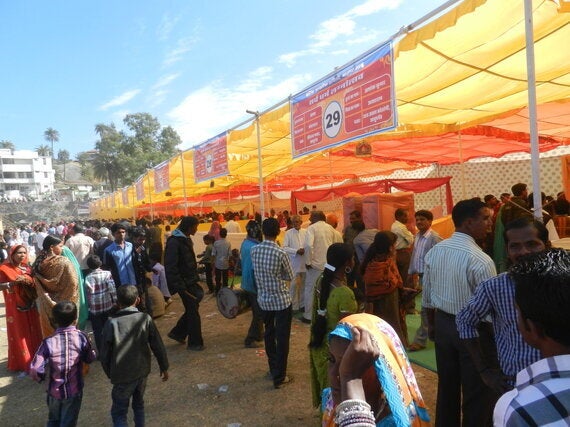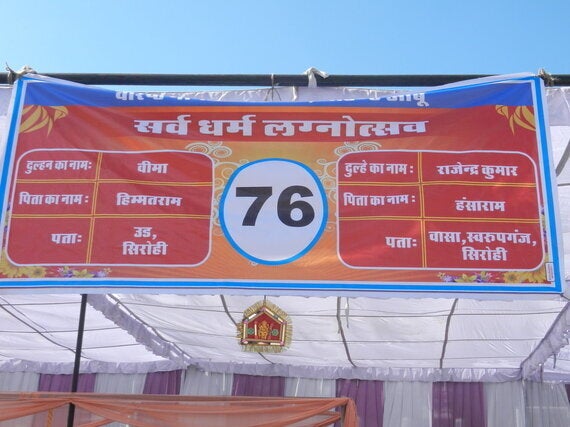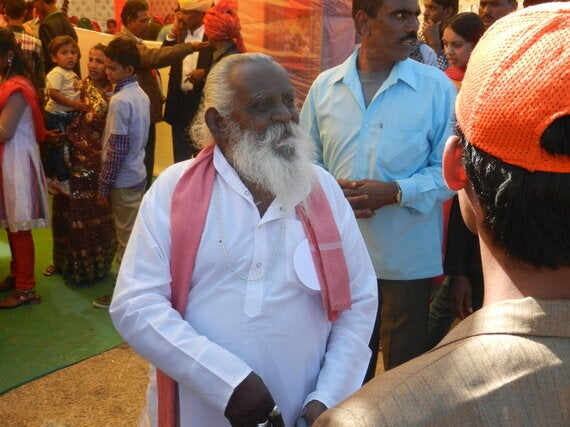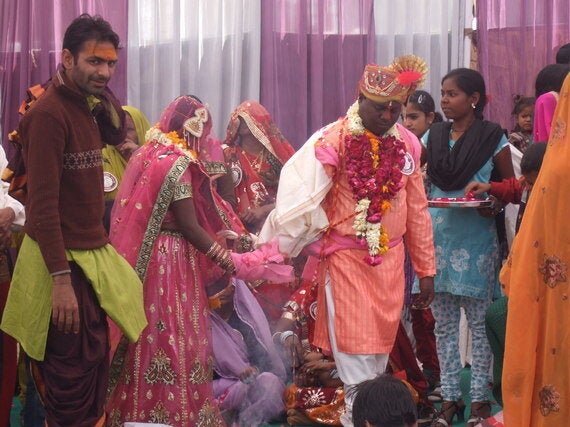It is Valentine's day, and for the first time ever, an enormous multi-faith, multiple wedding has been arranged in Mt Abu, Rajasthan. It takes place in a big bowl of dust which is still called 'The Polo Ground', but which probably hasn't seen any polo played since the days of the Raj, when this pretty hill retreat was the holiday resort and sanatorium for British civil service officers and their families. The whole town has come out to celebrate, there is a festival atmosphere; the sun is shining in a pellucid sky, and the scene is abundantly colourful.

The Polo Ground is surrounded by a row of numbered marquees in yellows, pinks and oranges, where one hundred and ten couples - from all castes and all religions - are due to be wed today. Excitement is tangible. The man who organised it all - Dr Gyan Prakash - assures us that there are all religions represented, although we do not see any of the surprisingly numerous Christian or Jewish Indians present. It is mostly a Hindu and Moslem affair, a noble thing in itself. And when he says 'all castes', I suspect he means there were marriages from all castes planned, not that there were going to be marriages between castes. The differences in the wealth of the families is quite apparent - some of the tent booths are much more lavishly decorated than others, with glittering silver ribbons and flags. Nevertheless, there is an overwhelming feeling of universality and companionship. All the tents are shining and billowing in the breeze and the pale, translucent dust kicked up by the crowd catches the sunbeams.

Dr Prakash is a charming, twinkly man dressed in immaculate white suit and tie. A retired Government Health administrator and ex-director of the Mt Abu Hospital, he is brimming with joy and pride at the achievement of this special day. "The astrology is auspicious for today" he beams. Astrology is very important in matrimonial matters in India; the ads in the matrimonial pages of the Times of India, for instance, are always keen to stress the astrological positions of the potential bride or groom. Until recently, in hotel lobbies in Delhi and Mumbai, alongside the signs for 'concierge', 'spa' and 'reception' it was not uncommon to see a sign for 'astrologer'. It may seem strange to westerners for a society to put so much store by something as unscientific as astrology. But then again, the world's economists have not had a much better success rate at predicting the future, have they?
I first came to Mt Abu when I was 20, in 1973, and although I have since returned to India many times, until last year I had never revisited Mt Abu. It became a place embellished with fantastical memories, a place I had described countless times to my partner, to the extent of boring her. When, in 2013, we tentatively discussed the idea that perhaps it was time we considered getting married - twenty five years is a very long courtship - it somehow seemed essential to me that I take her there so she could see for herself the place that had been so formative for me. We didn't know then, about the Valentine's Day marriage-fest; that is a complete coincidence. An auspicious day indeed.

For the fifty or so Muslim marriages on this day, there is one large tent, rather than the many smaller ones of the Hindu marriages. Here, the weddings are being conducted one after the other; a short ceremony, then onto the next. The Hindu tents on the other hand, are full of what seems like endless ritual. The couple have to walk around a small wood and incense fire one way a number of times, then back the other. They wear massive, sparkly head-dresses and jewellery and have flower petals thrown over them by relatives. The one thing both religions have in common, it seems, is that the entire family are present and involved, not just as witnesses but as an essential part of the whole process.
The atmosphere in both areas is bright and cheerful, crowds have gathered to walk around the ground, looking at all the different weddings, as they would at a fairground, or a Saturday market. Everywhere is lurid colour and noise; loudspeakers blare and people chatter. Children come up to us and want to shake our hands. It is only as we wander out of the gates of the Polo Ground that we realise we are the only white people there. We are conspicuously the outsiders on this beautiful day of union and harmony between the religions.

On our way out of the Polo ground, we bump into another old man, also dressed in white, who explains to us, beaming, that in India it is not just one individual marrying another individual, no, "it is one whole family marrying another family." This is something we are told again and again and goes some way to explaining the lengthy courting negotiations that are part of any arranged marriage. Not for an Indian a quick romance followed by a dash to Las Vegas and a hangover the next day.
And as for my partner and I? Well, reader, I married her. Not there and then in Mt Abu, obviously, but as soon as we could after our arrival back in England. With as many of our families around us as was possible. Another auspicious day, of course.

All photos blogger's own